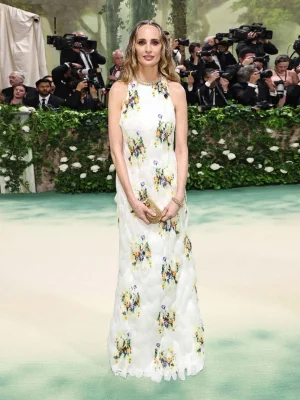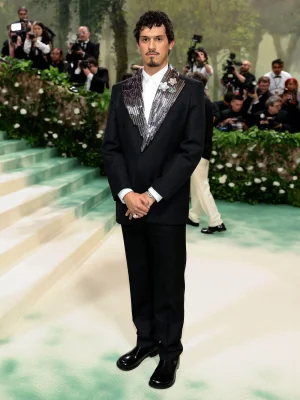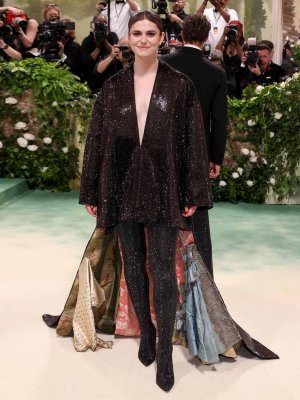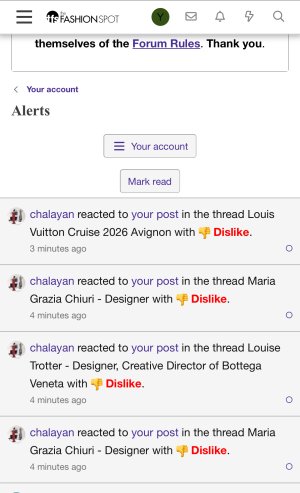BOF
Delphine Arnault Confirms Jonathan Anderson’s Dior Takeover
In a rare in-depth interview, the Dior chief executive talks to BoF’s Imran Amed about the logic for hiring Anderson to oversee both the men’s and women’s sides of the business and how the French mega-brand plans to recapture customers amid a sharp downturn in the luxury sector.
By Imran Amed
02 June 2025
BoF PROFESSIONAL
The Daily Digest Newsletter
The essential daily round-up of fashion news, analysis, and breaking news alerts.
Plus, access one complimentary BoF Professional article of your choice, each month.
ROME — Delphine Arnault is buoyant as she explains the logic behind one of LVMH’s highest-stakes designer appointments in years: former Loewe creative director
Jonathan Anderson will succeed
Maria Grazia Chiuri at Christian Dior, putting the women’s and men’s sides of the group’s second-biggest fashion label — and French national treasure — under a single creative director for the first time since Monsieur Dior himself.
We are having breakfast in Rome, where the next day Chiuri staged what would prove to be her
final runway spectacular for Dior, but Arnault’s mind is already sharply focused on reviving the fortunes of a brand that quadrupled revenue from €2.2 billion ($2.5 billion) in 2017 to €9 billion in 2023, according to estimates from HSBC, before being hit hard by a sharp slowdown in luxury demand.
Delphine, the eldest child of LVMH chairman
Bernard Arnault and Dior’s chief executive, has been schooled in the luxury business for more than 20 years. Right from her early days working at Dior, where she spent 12 years before moving to LVMH stablemate Louis Vuitton for a decade-long stint as executive vice president overseeing product-related activities, she has taken a particular interest in cultivating relationships with creative talents in the industry. In 2014, she founded the LVMH Prize, which has become the industry’s most prestigious award for emerging designers.
-
When she first met Jonathan Anderson in a small apartment he had rented near the Gare du Nord in Paris about thirteen years ago, she was struck by his creativity and clarity of vision. Shortly thereafter, in 2013, the group took a minority stake in his fledgling JW Anderson label and appointed him creative director of the Spanish leather goods brand Loewe, founded in 1846. Loewe had a rich heritage in craft, but had failed to gain commercial traction under LVMH’s ownership following its acquisition in 1996.
Anderson transformed Loewe from a sleepy heritage brand without a clear fashion vision into one of the luxury industry’s most desirable, culturally relevant labels. Building everything around his personal obsession with craft, which became the defining purpose for the brand, he established a consistent brand framework, created with longtime collaborators M/M Paris, that seemed to elevate and amplify whatever he put inside.
-
The Puzzle bag, launched in 2015, became an instant brand icon, leveraging Loewe’s deep expertise in leather goods manufacturing. He established the Loewe Foundation Craft Prize in 2016 to celebrate and support contemporary craft. And his Loewe fashion shows became one of the highlights of Paris Fashion Week, pushing forward his creativity while showcasing his talent for curating artists, celebrities and other cultural figures.
During Anderson’s eleven-year tenure, Loewe’s estimated annual revenues grew from around €200 million to more than €1.5 billion, according to market sources.
Mission accomplished.
But to retain an energetic and ambitious designer like Anderson, Arnault knew she needed to give him a new challenge. In April, Mr. Arnault, in response to a question at LVMH’s annual shareholders meeting, unexpectedly confirmed one of fashion’s worst-kept secrets: that Anderson would be taking on the creative leadership of Dior’s men’s collections. Anderson was already in the process of assembling a team and preparing for his Dior Homme debut on June 27 during the Paris menswear shows.
Dior will skip the Haute Couture shows in July, meaning we won’t get a glimpse of Anderson’s vision for womenswear until Oct 1, during what is shaping up to be a historic and hyper-competitive fashion month which will also feature designer debuts at Chanel and Gucci, as well as at Balenciaga, Loewe, Bottega Veneta, Versace and Jil Sander, as a number of top brands recast their creative leadership to help bolster sales in a difficult luxury market
“Having worked within the LVMH group for over a decade, I’m deeply grateful for the trust and support Bernard Arnault and Delphine Arnault have given me over the years, allowing me to develop my voice as both a designer and a leader,” told BoF in a brief written statement. “Their decision to appoint me as creative director of Dior is the ultimate expression of that trust, and I’m incredibly humbled and honoured by this opportunity.”
“Jonathan Anderson is one of the greatest creative talents of his generation. His incomparable artistic signature will be a crucial asset in writing the next chapter of the history of the House of Dior,” added Bernard Arnault.
No doubt. But Anderson surely has his work cut out for him.
In revenue terms, Dior is about four times the size of Loewe so his new job comes with a significant increase in scale and responsibility.
Anderson will go from designing nine collections per year at Loewe to 10 collections per year at Dior, including, for his first time, two haute couture collections. His sprawling remit for Dior will come on top of his responsibilities at JW Anderson, where he will continue to design six collections per year, according to the brand’s chief executive, Jenny Galimberti. While there will be no JW Anderson shows in 2025, the brand will be hosting a number of events and presentations, and will reveal a new go-to-market strategy in July focused on local craft and making. Then there’s also the ongoing JW Anderson collaboration with Uniqlo, which is another two collections per year.
That’s a total of 18 collections per year, meaning Anderson is set to become the industry’s most prolific, multi-tasking designer since Karl Lagerfeld.
What’s more, Anderson is joining Dior at a challenging moment. Sales at LVMH’s fashion and leather goods group, which houses Louis Vuitton and Dior, were down 5 percent in the first quarter of 2025, missing analyst expectations. While LVMH does not break out performance by brand, chief financial officer Cécile Cabanis said in the company’s most recent earnings call that Dior performed “slightly below” the division average. Bernstein analyst Luca Solca estimates that sales at Dior were down mid- to low- teens in Q1 2025, a significant deceleration after years of unprecedented expansion.
Like its main rival Chanel, Dior is contending with a value-for-money issue after implementing some of the industry’s most aggressive price hikes. Between 2020 and 2023, Chanel’s prices rose 59 percent on average, while Dior raised prices by an average of 51 percent, according to analysis by Bernstein. Some customers seem to have rejected the price increases and become tired of the ubiquity of luxury fashion, and are focusing more of their spend on travel, hospitality and fine jewellery.
Can Anderson do for Dior what he did for Loewe? There’s no doubt it’s a mammoth job. But Arnault contends that his unique blend of creativity and cultural intelligence, his proven ability to design commercially successful luxury products and his experience in leading and inspiring creative teams makes him the obvious choice to write Dior’s next chapter.
The Logic Behind the Appointment
Imran Amed: I think what everyone’s really interested in understanding is the thinking behind your decision. When you’re picking a designer for a brand as important as Dior and you decide on someone like Jonathan, what thinking goes into that? Why is he the right choice?
Delphine Arnault: Jonathan was the obvious choice. I think he’s the most talented designer of his generation. I remember going to see his collection in Paris, near Gare du Nord in this little flat on the fourth floor with no elevator. I rang at the door, and there he was. That was maybe 13 or 14 years ago. I’d never heard of him before, but even then, at maybe 24 years old, he was incredibly sharp — very talkative, super smart, and full of ideas. He’s still like that today.
What he’s done at Loewe is remarkable. He may only be 40 years old, but for his age he brings a lot of experience. Dior is a very big house, and he’ll have big teams to manage. We have the best
ateliers, both in
haute couture and ready-to-wear, and he’s going to have to work with very large teams. That requires real skill. At Loewe, the team isn’t as large, but he’s proved he knows how to build and manage teams, how to bring people together, and how to choose the right collaborators. It’s a gift. It’s not the same to manage a small team at a small brand and arrive at a place where you have to manage a lot of people.
We’ve talked a lot. I think I haven’t missed a Loewe show —
maybe one — but you know, I’ve been following his path for a long time. I love finding new talents, and I was a big supporter of his talent early on.
My father was also involved in the choice of Jonathan, of course. He’s been also following his work and seeing him often throughout the years.
Jonathan is also very loyal. He stayed 11 years at Loewe, even though I’m sure that he had many [other] propositions.
For all these reasons he’s the perfect choice for Dior.
IA: So, how and when will we start to see Jonathan’s vision for Dior come to life?
DA: Jonathan already started — he began working on men’s in February. Even though we didn’t announce it formally, my father mentioned it at the
assemblée générale in April — that it had started back in February. Everyone’s very excited, and there’s a new energy in the men’s teams. You can feel his vision.
You know him too — he’s someone with a very clear vision. He’s passionate about Dior. I don’t want to speak for him, but from his side, Dior was always close to his heart. When I spoke to him about what he might do after Loewe, Dior was the house he connected with most deeply.
In many ways, he shares similarities with Monsieur Dior, who loved art — he was a gallerist. Jonathan is also passionate about art and has done many collaborations with artists throughout his career. He also loves gardening and flowers, like Monsieur Dior.
And he’s quite superstitious too — Monsieur Dior was as well. The day we signed the contract, Jonathan actually signed at 2:00 a.m. because he didn’t like the date, so he waited for it to change to the next day.
IA: Aha, he wanted a contract date that he thought was more auspicious! What about shows?
DA: He’s going to have many shows — it’s a big rhythm. His first presentation of the women’s vision will be the
ready-to-wear show on October 1st in Paris. Then of course, there will be the
haute couture show in January. But his first official show for Dior is only a few weeks away. It will be on June 27th, where he’ll unveil his first men’s collection — so that’s also very exciting.
One Designer, ‘One Dior’
IA: You mentioned the men’s show, which is interesting because this is the first time at Dior that there will be a single designer doing men’s and women’s. It’s always been two separate designers. This is the first time you’re bringing it under one designer. It’s a really big job.
DA: It’s the first time since Monsieur Dior himself, because he did a little menswear — ties, etcetera. So yes, it’s the first time since Christian Dior.
Of course, it’s a big role, but for our
maison, I believe it brings more consistency — in the product and in the communication. It’s a good thing to have more coherence, and to have one designer, one vision for the house.
It is a lot of work, I can see that. He will have many shows and a lot of collections to work on. But he has an amazing team. We truly have
ateliers that are exceptional — the best in the world. He’s going to work closely with them.
IA: The ‘One Dior’ strategy is something that you’ve been working on for some time. Not only to achieve alignment between the men’s and women’s fashion collections, but also alignment with Dior beauty. Can you explain ‘One Dior’ and why it is important for you as CEO?
DA: I think that the consumer doesn’t know that there’s a CEO of fashion and a CEO of beauty. For the consumer, Dior is one brand. Whether you see a makeup ad, a perfume ad, or a fashion ad — it’s all Dior. So I think the ‘One Dior’ strategy is very important.
That’s also why we have Olivier [Bialobos], who’s in charge of ‘One Dior’ and ensuring coherence across the communications.
But if I go back to the fashion side of Dior, I think it’s going to bring a lot of coherence — in the products, in the communications, in the windows. It’s a lot of work. We still need to see what he’s going to create, but I think he wants to bring more coherence across the collections.
It’s very interesting to see what he’s drawn to, what interests him in the history of the brand, and to see how he’ll bring those codes back into modernity. From what I’ve already seen on men’s, it’s very impressive what he’s doing.
Obviously, we have a lot of icons that he’s really passionate about. He loves the Lady Dior [handbag], for example. He’s been spending a lot of time in the archives — not just looking at what Christian Dior created, but also what all the other designers have contributed. It’s not only about ready-to-wear or
haute couture, but also shoes, with Roger Vivier.
IA: Would you give him the opportunity to reinterpret some of these icons? When you say he’s really interested in the Lady Dior, is there an opportunity for him to put his own twist on them?
DA: Yes, as you know, we’ve always given our designers — our artistic directors — a lot of freedom in terms of creativity. It’s really one of the key traits of LVMH: to give a lot of liberty and trust to our artistic directors.
I’m excited to see what his full vision is going to be, because he only started a couple of months ago. I think the whole company is excited. And also the clients.
Closing the Maria Grazia Chapter
IA: I want to talk about clients in a minute, but before we do that — this moment clearly closes a chapter for Dior with Maria Grazia. And on reflection, it’s been a pretty remarkable chapter. The business has grown substantially under her leadership. It was also the first time a woman designed for Dior. As a woman CEO, with the two of you leading the growth of this business, what do you think Maria Grazia’s legacy is at Dior — and what did it mean to have a woman designing for this brand?
DA: I really [want to] thank Maria Grazia so much. She impresses me every day. She’s very strong, very passionate, and has such a clear vision. She developed the collections at Dior in a way that was truly remarkable, as you said. She put women at the centre of her work. For the first time, women had a voice, and also the women artists.
I remember her first show. I was sitting next to Jennifer Lawrence and she already had the J’Adior shoes and the jeans and the t-shirt and the bar jacket that was with an easier fit. And you know, when you see things for the first time — because at the time I was working at Vuitton — it takes a minute, like hearing a song for the first time that you know you’re going to love. And I remember thinking,
“Wow, this is so cool.” It was such a new way to present Dior.
She continued to develop that with a very clear idea of what she wanted to do, empowering women, empowering women artists, empowering women photographers.
She’s really done so much for her house. She really has a vision. I really admire her and really loved working with her. She’s super inspiring.
IA: What changes now? Because once again, it’s a man designing the women’s collection. Maria Grazia had a real connection with women — and with a very strong, diverse female customer base. How do you make sure that connection is preserved?
DA: Maria Grazia created a beautiful body of work and did so much for women. And Jonathan designs both womenswear and menswear. He also has many women in his team. As you know, when you have a studio, you have designers across all categories — bags, ready-to-wear,
haute couture, shoes — and each category often has its own dedicated designers. It’s a collective effort.
There are also many women who inspire him. And yes, of course, it will be different — but I think that’s what’s interesting.
And it’s also my responsibility, as CEO, to know when it’s time for change — and to make that change happen.
IA: It took some time for all of this to be revealed ... the news had been circulating in the industry for a while — there was a lot of speculation that these changes were happening. Why did you decide to announce things in stages? Why did it take so long?
DA: It’s a good question. Well, we talked a lot with Maria Grazia, and we thought that it would be great for her last show to take place in Rome, her hometown. I think for her, it means a lot personally. She wanted it to be something joyful and so we agreed that we would announce that she decided to leave after her show in Rome — and not before. So out of respect for her, we decided to do that. That’s why it took a little bit of time.
What Luxury Customers Want
IA: The luxury industry is experiencing a sharp downturn, as luxury customers’ preferences are changing. From your perspective, how are they changing? What are luxury customers — particularly women — looking for now?
DA: You know, in every industry, you have cycles. And it’s in the tougher moments that big innovations or inventions happen.
If you take the history of Christian Dior — the New Look was created in 1947, after the war. It was something totally new. So I think that, yes, big inventions often come during these cycles.
As for the luxury customer — it’s hard to generalise — but I think they’re looking for authenticity. Quality is something that’s extremely important: quality in the manufacturing, in the products. And also, having products that are iconic. We have a lot of iconic products, like the Bar jacket, the Lady Dior, just to name a few.
So yes, everything moves in cycles, and I’m sure new things are going to be invented and created.
IA: What is it that Jonathan offers for this critical moment when the industry needs innovation and creativity?
DA: You know him very well. He’s very in tune with his generation. He’s very connected — especially with young people. He speaks to a wide audience.
He’s passionate about craft, about art — and he’s proven that at Loewe. I think he’s also going to surprise you, and everyone… and even me, maybe!
I can’t say too much about what he’s going to do, but I think his vision, his passion for craft, and also for leather goods — is going to be something very exciting in the years to come.
And you know, when you have a creative change, it always takes a little bit of time to really see the new vision, the new direction for a designer.
As I was saying earlier with the first show of Maria Grazia — the T-shirt, the jeans, the Bar jacket — it takes a couple of seasons. You don’t necessarily understand it immediately. But when you look back at all her collections, you start to understand it better.
IA: One thing that’s become a touchpoint for the industry is pricing. There’s a lot of pushback from customers now. Brands like Dior have increased their prices a lot over the last few years. Have we reached a limit on that?
DA: Yes, I agree with you. The pricing strategy is a big question. I think that prices can be increased if you have an increase in quality as well, an improvement in the product.
So if you increase the quality of your product, you can increase the price. Now, there is also some inflation in the cost of materials. The production costs are higher every year. The leather costs more, as well as the metallic accessories. There’s always inflation in different parts of the product.
It’s up to every house to decide what to do as a pricing. For us, I think, increasing pricing should be linked to an increase in quality.
And recently we’ve had some new people come to Dior, to focus on this. We have [Chief ] Pierre-Emmanuel Angeloglou, whom I worked with at Vuitton. He arrived at Dior on April 15. We also have a new industrial director Nicolas Carré who comes from Louis Vuitton, and chief industrial officer Giorgio Striano looking over all the activities.
Of course, Jonathan is also going to bring a lot of newness with his creativity. It’s hard to speak about his creations, I think he should speak about it, it’s going to be better said that way.
IA: Earlier, you said all industries have cycles. In your view, is the current issue cyclical, or is there also a structural issue in the way the luxury industry works that needs to be addressed?
DA: I’m very optimistic about the future, and about this new direction and vision that Jonathan is bringing — especially in terms of connecting with customers.
As I was saying earlier, it’s all about the product — but stores are also extremely important. The service, the decoration of the stores — it’s all part of the mix.
We’re opening a store in New York in July, on the corner of Madison and 57th. That’s going to be a very big message for the American market. It will be a beautiful store, almost the size of the Avenue Montaigne store. We’re also opening a store on Rodeo Drive in September — so this year, in terms of retail, is really the year of the American market for Dior.
Having those stores — like Avenue Montaigne, and the new ones in New York and Rodeo Drive — is extremely important for the development of our
maison.
They give a full vision of the brand: the men’s collection, the women’s collection, perfume, jewellery, and even some restaurants. It’s where you really understand the full Dior universe. And I think the attention to service, the way you’re welcomed into the store — is going to be very, very important for us.
You know, Dior still has very big potential. The name alone is magical. Jean Cocteau said: “
ce nom magique qui melange Dieu et or”
IA: A mix of god and gold?
DA: Yes, Dior is a magical name that is known all over the world. We’ve grown a lot, but there’s still a lot more growth potential at Dior.
This interview has been edited for length and clarity.











